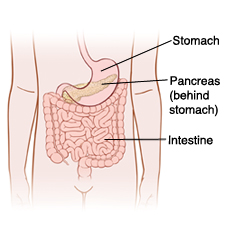Diabetes and Your Child: Understanding Type 1
Diabetes and Your Child: Understanding Type 1 Diabetes

You’ve been told that your child has type 1 diabetes. This means his or her body has trouble using a sugar called glucose for energy. Diabetes is a lifelong condition. Left untreated, it can lead to serious health problems. But diabetes can be managed so your child can live a full, healthy life.
How the body gets energy
When your child eats, the digestive system breaks down food. Some of this food is turned into glucose in the intestine. Glucose (also called blood sugar) gives energy to the body’s cells. It travels through the blood to reach the cells. But glucose needs the help of a hormone called insulin to enter cells. Insulin is made by an organ called the pancreas. Insulin is released into the blood, and travels to the cells just like glucose. When insulin reaches a cell, it acts like a key. It opens a “door” into the cell so glucose can enter.
When your child has type 1 diabetes
In children with type 1 diabetes, the pancreas stops making insulin. Food is still broken down into glucose. And glucose still travels to the cells. But without insulin, glucose can’t enter the cells. Instead, it builds up in the blood. The liver puts more glucose out into the blood. Too much glucose in the blood is called hyperglycemia (high blood sugar). Without glucose, your child’s cells don’t get the energy they need. And over time, high blood sugar can cause other health problems.
What are the causes of type 1 diabetes?
The exact cause of type 1 diabetes is not known. We do know that it’s NOT caused by eating too much sugar. Type 1 diabetes can run in families. Or, your child may be the only person in the family to develop type 1 diabetes. The important thing to remember is that it’s not your fault. Nothing you or your child did caused his or her diabetes.
What are the symptoms of type 1 diabetes?
When the pancreas stops making insulin, the body’s cells become starved for energy. This can cause your child to feel tired and rundown. Your child may feel or have:
-
Very strong thirst
-
Increased urination
-
Blurry vision
-
Tiredness for no obvious reason
-
Nausea, vomiting, and belly pain
-
Extreme hunger
-
Headaches
-
Flu-like symptoms
-
Bed wetting
-
Unexplained weight loss
-
Difficulty concentrating
How is type 1 diabetes diagnosed?
Simple blood tests can help the health care provider determine if your child has type 1 diabetes. These tests check for a high level of glucose in your child’s blood. Glucose tests may need to be repeated in order to confirm the diagnosis.
How is type 1 diabetes treated?
There is no cure for type 1 diabetes. But the good news is that the condition can be managed. Your child’s pancreas is not making insulin. So insulin has to be put into your child’s body. But insulin can’t be taken as a pill. Instead, it is most commonly taken by injection (shot). The idea of giving your child shots might seem scary at first. But most parents and children find that it’s easier than they thought. Your child’s healthcare provider will teach you how to check the level of your child’s blood sugar. This tells you how much insulin to give your child to keep blood sugar in a healthy range.
What are the long-term concerns?
People with a blood sugar level that is too high over many years can develop health problems. These problems can affect the heart, eyes, kidneys, and nerves. You CAN help delay or prevent these problems in your child. To do this, manage your child’s blood sugar as directed. Support and role model a healthy lifestyle, and teach your child in an appropriate way how to manage their diabetes..
The “honeymoon” phase
After diagnosis, your child’s pancreas may still be making a little insulin on its own. This is called the “honeymoon” phase. At this time, your child’s blood sugar may be managed with very little insulin. The honeymoon phase may last months, or even years. Because of this, you may think that your child’s diabetes has gone away or been “cured.” But this is not the case. As time goes on, your child’s pancreas will stop being able to make any insulin at all. Talk to your child’s healthcare provider about managing your child’s blood sugar during the honeymoon phase.
Resources
For more information about diabetes, visit these websites:
-
American Diabetes Association www.diabetes.org
-
Children with Diabetes www.childrenwithdiabetes.org
-
Juvenile Diabetes Research Foundation www.jdrf.org
-
American Association of Diabetes Educators www.aadenet.org
-
American Association of Clinical Endocrinologists www.aace.com
-
Endocrine Society www.endocrine.org/topics/diabetes
-
National Diabetes Information Clearinghouse www.diabetes.niddk.nih.gov
NOTE: This sheet does not give all the information you need to care for your child with diabetes. Ask your child’s healthcare provider for more information.
Updated:
September 17, 2019
Reviewed By:
Robert Hurd MD,Marianne Fraser MSN RN,Raymond Kent Turley BSN MSN RN